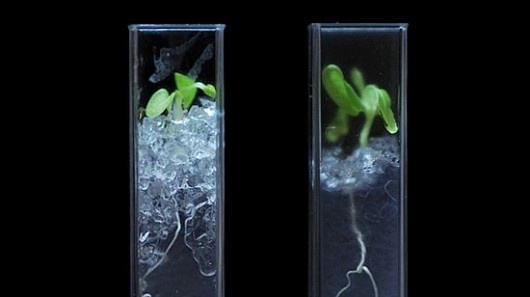Scientists invent transparent soil to reveal the secret life of plants
By David Szondy
October 3, 2012

Lettuce grown in transparent soil developed by researchers at the James Hutton Institute and the University of Abertay Dundee in Scotland
Most peopleís image of plants is actually upside down. For most of our photosynthetic friends, the majority of the plant is underground in the form of an intricate system of roots. The bit that sticks up is almost an afterthought. Thatís a problem for scientists trying to study plants because growing them in media that allow you to see the roots, such as hydroponics, doesn't mimic real soil very well. Now, a team of researchers at the James Hutton Institute and the University of Abertay Dundee in Scotland has developed an artificial transparent soil that allows scientists to make detailed studies of root structures and subterranean soil ecology on a microscopic level.
Developed by a team led by Lionel Dupuy, a theoretical biologist in the Ecological Sciences group at the James Hutton Institute, the transparent soil is the result of two years of research. It doesn't look much like conventional soil. In fact, itís a bit like those high-tech ant farms where instead of sand, the ants burrow through a jelly that also provides them with food and water. However, mechanically, it does mimic real soil. It supports root structures, holds suspended minerals, can be colonized by microorganisms and even exchanges gases like soil.
Itís made from granules of Nafion, which is a lot easier than calling it a sulfonated tetrafluoroethylene based fluoropolymer-copolymer. Used in batteries, fuel cells and a wide range of applications, Nafion is naturally transparent, but in order to make it translucent enough for for botanical purposes it needs a special water-based formula. Forming the polymer into pellets allows it to mimic soil particle properties, such as forming channels, retaining water and nutrients and sustaining plant growth. Fluorescent dyes can also be added to it to aid studies.
Researchers say that the transparent soil could be used to study root systems, help breed crops with more efficient roots that need less fertilizers, and study the ecology of plants and microorganisms. Currently, the team is working on controlling the properties of the transparent soil and bringing down its cost.
The team's research is published in the journal PLOS One.
Source: James Hutton Institute
About the AuthorCopyright © gizmag 2003 - 2012 To subscribe or visit go to: http://www.gizmag.com
